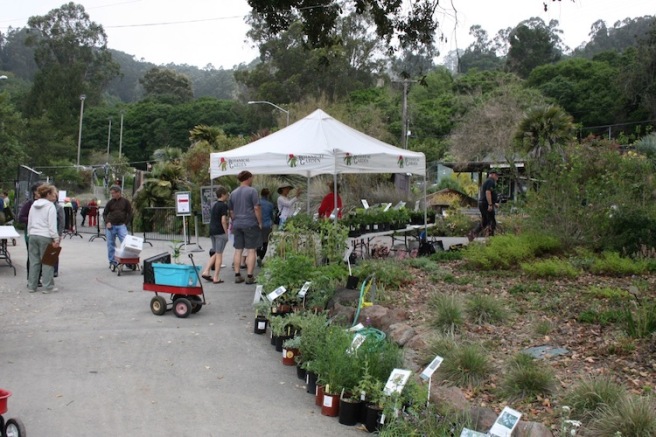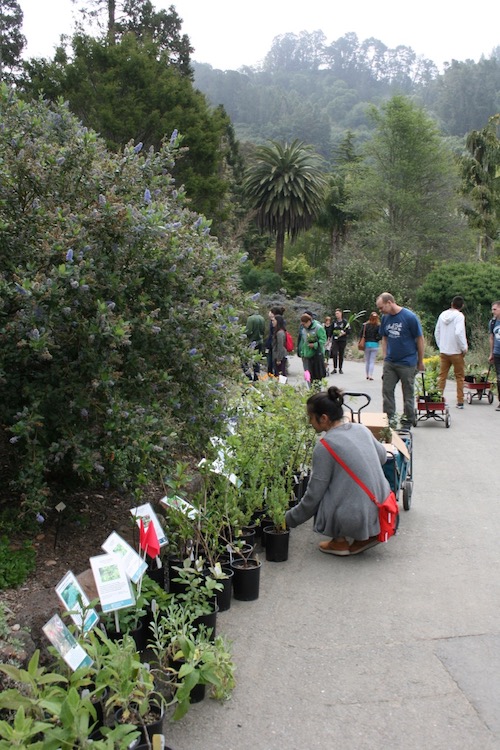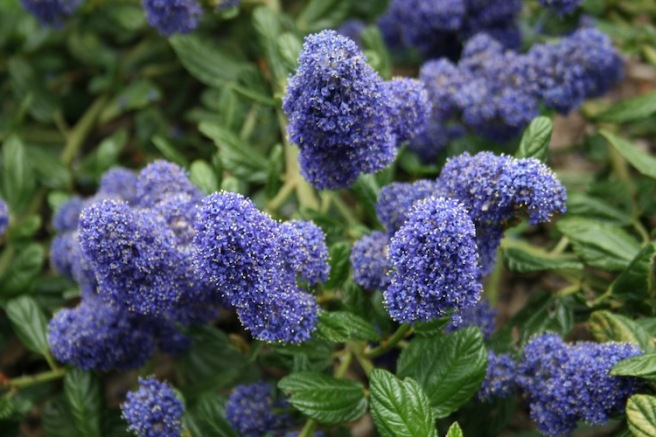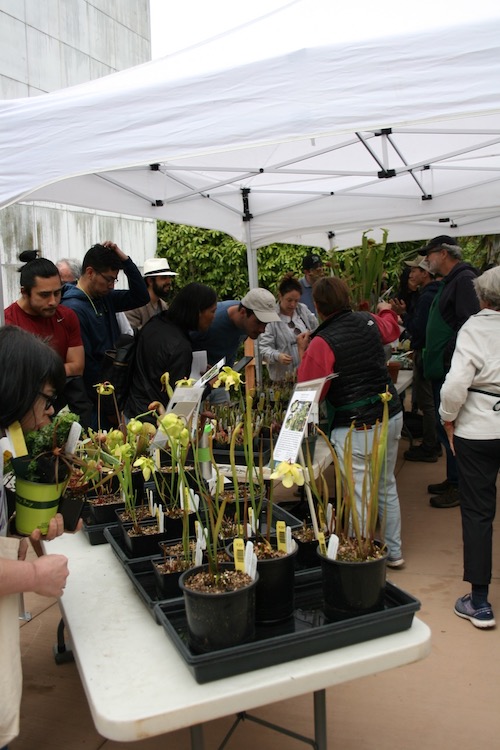The second day of this Bay Area road trip is devoted to a visit to the University of California Botanical Garden at Berkeley to take in their spring plant sale. The sea mist was still hanging in the air as I made my way up into the Berkeley Hills overlooking the San Francisco Bay. All I can say is thank goodness for navigation–a mere four miles from my hotel must have had 2 dozen lefts and rights to get to the 2 lane road into the hillside campus.

The garden’s parking lots were full and signage led me uphill to the overflow parking some 3/4 of a mile away at Lawrence Hall. A free shuttle awaited to ferry us back down to the garden.

It didn’t take long for me to realize I could not take photos, peruse plants and pull my wagon all at the same time so pictures are few because in this case, plants rule. The garden’s collections are all closed for the sale so only the main walkway seen here is accessible with all secondary paths being roped off.
The Botanical Garden was formally established on the UC Berkeley campus in 1890 with its current 34 acre location in Strawberry Canyon since the property was purchased in 1909. Ten thousand plant types are organized in 9 geographic regions of naturalistic plantings from Italy to South Africa, along with a major collection of California native plants. With the little bits I could see from the sale site I know I want to schedule another visit to see all there is off this beaten path.

Here are a few vignettes visible from the walkway…



The fabulous royal blue Ceanothus below was the backdrop for a display of varieties for sale.


It was identified as Ceanothus thyrsiflorus var. griseus ‘Kurt Zadnik’ and it was no surprise to me that all of this particular one had sold in the few minutes since the sale opened. It is such a benefit to us to be able to see a plant we buy in a gallon can at its mature size and in excellent health. The common appellation Carmel creeper could lead you to believe it is a prostrate variety–not so!

There were areas for trees and shrubs, California natives, succulents, shade lovers and sun cravers, houseplants and tropicals but the table with the biggest crowd was the collection of carnivorous plants. Amazing!

I gathered up and paid for my precious cargo. All but one of the plants I purchased was propagated onsite from the garden’s collection. My booty includes 4 salvias, two of which have been on my acquisition list for a few years, a coveted Campanula incurva to add to a dappled shade area and a pelargonium with interested red patterned foliage. A day with new plants is a very good day for me!



Pacific Ocean?! That is just part of it! All that clutter in the way of the view of the Pacific Ocean is San Francisco and the San Francisco Bay, with a few of the most scenic bridges. That is one of the most excellent views in the San Francisco Bay Area.
Oh, and the plant sale is nice too.
Is one of your salvias the black sage, Salvia clevlandii? That is one of my favorites because it is native here. I do not know all the cultivars of it. That Ceanothus thyrsiflorus really is splendid, even though I do not know the cultivars. The wild ones are in bloom here too.
LikeLike
You got me Tony, that’s what I get for writing a post on the fly and brain addled from garden gazing and plant shopping–of course it was the Bay not the Paciifc. I’m gonna to make that correction to the post right now! The salvias I purchased were S. corrugata, S. sagittata, S. dolomitica, and a S. greggii ‘La Luna’ (white one). Also The S. dolomitica is more a foliage plant as the flower isn’t particularly striking. Also for foliage I bought Ballota pseudodictamnus-Grecian Horehound. It was an interesting visit for me if for no other reason that I had never been to Berkeley before.
LikeLiked by 1 person
Oh, the Pacific Ocean is nice too . . . . I just think of it as a minor part of the view from there. I grew up around it, so I am not very impressed by an empty ocean. The Bay is more interesting. I worked there briefly in high school, setting markers out for boats to race around. It was a fun job for a weird purpose.
LikeLike
The Salvia gregii is almost too common in landscapes now, which takes the fun out of it somewhat. I typically prefer old cultivars, but nowadays, I prefer the less common cultivars of Salvia gregii, just because they are a bit more distinguished than those in landscapes. ‘La Luna’ is still uncommon. Of course, I do happen to like white. Salvia apiana is grown for the aromatic foliage, but I do not think that it is as pretty as the Salvia dolomitica. I really do not know because I have never seen a mature Salvia dolomitica. I do know that the Salvia apiana stinks when fresh!
LikeLiked by 1 person
PS also got S. blancoana, so called Spanish salvia. I DO have S. brandegei ‘Pacific Blue’ and S. clevelandii ‘Pozo Blue’ and ‘Winnifred Gilman’ already in my garden–all great plants.
LikeLiked by 1 person
‘Pozo Blue’?! I have never heard of it! Wow! I got to get some to go with the black sage we already have (in a different area of course). I like the black sage because it smells like the region outside of the Santa Clara Valley used to smell like decades ago. Even the cultivars smell like that! It used to be common in the wild. Pozo is near where I went to school. I am now wondering if it has a distinct aroma!
LikeLike
‘Pozo Blue’ is classified as S. clevlandii but is a hybrid with S. leucophylla. It is similar in appearance to ‘Allen Chickering’ and ‘Aromas’ but is supposed to have improved resistance to leaf spot according to Monterey Bay Nursery. This is its first year in my garden so I’ll let you know how it goes!
LikeLiked by 1 person
Well, if it is a hybrid, it is not naturally occurring. Well, it has a cool name at least. I have not met a black salvia that I didn’t like.
LikeLike